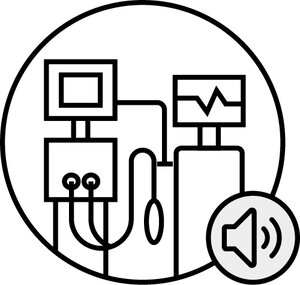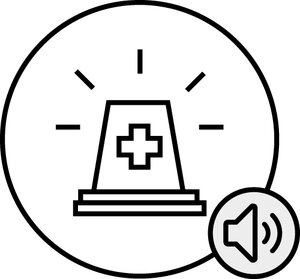


Noise pollution in hospitals is increasing worldwide. This is due both to the buildings' technical equipment and to increasingly complex medical devices. Treatment and monitoring equipment generate a constant background noise level with a sound pressure level of around 70 dB – roughly the background noise of a canteen with 50 people. Studies have shown that the average noise exposure in large hospitals is equivalent to that on a major road.





We have known for a long time that noise is partly responsible for mental and physical stress. Environmental noise levels have a demonstrable effect on our nervous system, our concentration, and our well-being. From 58 dB already the heart rate increases, and it can lead to disturbed sleep. However, rest and sleep are the most important factors in recovery and rehabilitation. Just as a long-term increase in noise levels makes us tense, silence has a relaxing and health-promoting effect.
Balanced room acoustics are just as beneficial to recovery as stabilising the patients' circadian rhythm. Biodynamic lighting concepts support natural hormone levels during the course of the day and thus regulate the alertness and tiredness curves. The higher the activation during the day, the more relaxed and regenerative the sleep. In addition, reduced noise levels in the hospital are beneficial for the regeneration of patients and reduces their length of stay in hospital.
In addition, balanced acoustic planning improves the quality of communication. In a medical environment, it is essential that the doctor, carer, and receptionist are clearly mutually intelligible and that the flow of information is not impaired by reverberation, disturbing sound propagation, or background noise. Speech intelligibility in particular plays a major role. It must be sufficient to enable information to be passed on clearly and quickly. However, privacy must be maintained during confidential medical consultations. For example, at the 24-hour nurses’ station it is important to be able to communicate the most important things quickly while exchanging sensitive data without this being overheard by other patients. Good room acoustics therefore have a positive effect on the well-being and recovery of patients and also optimise the processes in healthcare facilities themselves.
Healthcare workers operate under stressful conditions. They carry out critical activities and must make serious decisions – often under high pressure. Precision in every action is a prerequisite, as is efficiency in treatment, to provide adequate care to all patients as quickly as possible.
High noise levels act as an additional stress factor. It affects both the well-being of the staff and the quality of their work. Studies have shown that the psychological effects of noise in clinical settings have a negative impact on concentration and performance, as well as accelerating fatigue. Poor comprehension, irritability, and a feeling of being overwhelmed thus put a strain on medical support as well as on the relationship with the patient. Room acoustics tailored to requirements counteract this by creating a harmonious working environment even where high noise levels are unavoidable. This increases the quality of work and the satisfaction of the staff.
Elderly people are overrepresented in hospitals and care homes due to their physical constitution. Since visual and auditory performance declines with age, lighting and room acoustics need to be adapted accordingly. Appropriate acoustic measures enable elderly patients to perceive their surroundings better and to organise their day more actively. Improved acoustics also promote communication and participation in social life in the care home. Sound-absorbing surfaces are ideal because they reduce the reverberation time and thus optimise speech intelligibility. This has a considerable influence on the relationship between doctor and patient, for which mutual intelligibility is critical.
Bright, calm, and friendly rooms counteract the clinical sterility of a hospital environment. In addition to pleasant, homogeneous lighting, the room’s acoustics also play its part. The more balanced the background noise, the better the organism can rest. Modern, design-oriented acoustic elements optimise the acoustic conditions in the room and act as decorative design elements that guide the patient's gaze.
The requirements for comprehensive room-acoustic planning in the healthcare sector are many and varied. Numerous standards must be considered, as well as the individual needs of patients. To meet this complexity, we work with a network of different partners. This allows us to perfectly coordinate lighting and acoustics. In addition, we offer acoustic planning in three service packages, which – depending on room size and specific project requirements – include different services.